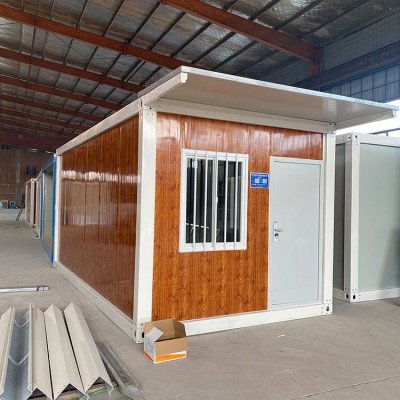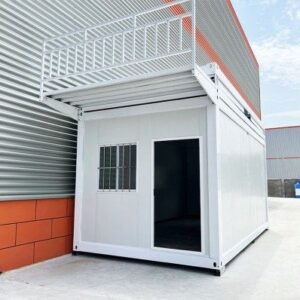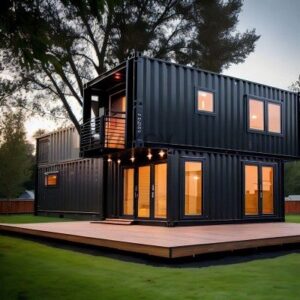If you’ve ever wondered how to build a house out of shipping containers, you’re tapping into one of the most exciting trends in modern, sustainable living. Shipping container homes offer a unique blend of affordability, speed, and eco-friendliness that traditional construction just can’t match. But turning a steel box into a cozy, functional home requires more than just stacking containers—you need a clear, step-by-step approach to navigate design, permits, modifications, and finishing touches.
In this guide, you’ll get everything you need to confidently start your container home project, from sourcing containers to tackling insulation and local building codes. Ready to rethink what “home” can be? Let’s jump in.
Understanding Shipping Container Homes
What Is a Shipping Container House
A shipping container house is a residential structure built using steel shipping containers as the main building blocks. Originally designed for freight transport, these containers provide a strong, durable, and modular framework ideal for housing. Converting shipping containers into homes has become a popular alternative to traditional construction, offering a distinctive blend of modern design, affordability, and sustainability.
Common Types and Sizes of Shipping Containers Used
Shipping containers come in standardized sizes, which makes planning and building container homes more straightforward. The most commonly used containers for residential projects include:
- 20-foot containers: Approximately 160 square feet of space, ideal for small studios or single-room units.
- 40-foot containers: Double the length of the 20-foot version, offering around 320 square feet of living area, commonly used for larger rooms or combined spaces.
- High cube containers: These are like standard containers but about one foot taller (9.5 feet vs. 8.5 feet), providing more headroom and a more spacious feel inside.
Builders often combine multiple containers in various configurations to create larger homes with multiple rooms and complex layouts.
Pros and Cons of Shipping Container Homes Compared to Traditional Buildings
Pros
- Cost-Effective: Containers are generally less expensive than traditional building materials, reducing the overall building cost.
- Speed of Construction: Since the steel shells are pre-made, the build time is typically faster.
- Durability: Designed to endure harsh shipping environments, containers are strong and resilient.
- Sustainability: Using recycled containers reduces waste and lowers the environmental footprint.
- Modularity and Flexibility: Containers can be stacked or connected horizontally, allowing creative design options.
Cons
- Insulation Challenges: Steel conducts heat and cold easily, so effective insulation is critical and can add to costs.
- Space Constraints: Containers have narrow widths (typically 8 feet), limiting interior space unless combined thoughtfully.
- Permitting and Zoning: Some locations have strict regulations or zoning laws that can complicate approvals for container homes.
- Potential for Rust and Corrosion: Without proper treatment and maintenance, containers can rust, especially in humid or coastal areas.
- Resale Perception: Although gaining acceptance, some buyers may still view container homes as unconventional, potentially affecting resale value.
Understanding these factors is essential when deciding if a shipping container home fits your lifestyle, budget, and local building environment. Yichen’s expertise in shipping container home construction ensures you get professional guidance tailored to your needs and the U.S. market standards.
Planning Your Shipping Container House Project
Before jumping into building a shipping container house, careful planning is key. This stage sets the foundation for a smooth project from start to finish, covering everything from space needs to legal requirements.
Assess Your Needs Size Design Preferences and Budget
- Determine your space requirements based on how many people will live in the home and your lifestyle (work from home, guests, hobbies).
- Choose container size and quantity: Common options are 20ft and 40ft containers. You can combine multiples for larger layouts or stick to a single container for a tiny home.
- Define your design preferences whether you want a minimalist look, a modern style, or something rustic with natural finishes.
- Set a realistic budget that covers container purchase, modifications, land, utilities, permits, and finishing. Factor in extra for unexpected costs.
Find a Suitable Location and Understand Local Regulations
- Location impacts everything: proximity to work, schools, amenities, and how easy it is to transport containers there.
- Check zoning laws and building codes for your area to confirm if container homes are allowed. Some neighborhoods or counties may have restrictions against alternative housing types.
- Contact your local building department early to understand permit requirements, inspections, and any special rules related to steel structures or container housing.
- Research utility access such as water, electricity, and sewage—this can be a major factor in site selection and cost.
Consider Environmental and Climate Factors
- Shipping container homes need to be adapted to local climate conditions to ensure comfort and durability.
- Insulation and ventilation requirements vary by region—cold climates need thicker insulation; hot climates require proper airflow and sun shading.
- Plan for rain, snow, humidity, or strong winds depending on your area, and select materials and finishes that withstand those elements.
- Consider orientation of the containers for sunlight, natural heating, and cooling efficiency.
By thoroughly planning these aspects upfront, you can avoid delays, cost overruns, and compliance issues. A thoughtful approach sets your shipping container home project on the path to success.
For more details on container options and sizes that fit your project, check out this 20ft container house guide.
Designing Your Shipping Container Home
When it comes to designing your shipping container home, you have two main routes: collaborating with an architect or opting for prefab container home designs. Both choices have their pros depending on how customized or quick you want your build to be.
Working with Architects or Using Prefab Designs
- Architect-designed homes offer complete customization. Architects can tailor the home to your exact needs, site, and style preferences, ensuring efficient use of space and integration with your land.
- Prefab container homes come with ready-made plans and components, often cutting down design and build time. These models are usually tested for efficiency and practicality, which can be a big advantage if you want to keep things simple and predictable.
Choosing between these depends on your budget, desired uniqueness, and timeline. Many find prefab designs a smart starting point, especially if you’re new to container home construction.
Important Design Elements
When designing your container home, some critical factors should guide your decisions:
- Insulation: Containers are steel boxes that conduct heat and cold, so good insulation is a must. Spray foam, rigid board, or blanket insulation are common methods to keep indoor temperatures stable.
- Ventilation: Proper airflow reduces moisture and keeps the air fresh. Plan for vents, windows, and possibly mechanical systems depending on your local climate.
- Windows and Doors: These should be strategically placed to maximize natural light and ventilation. Consider energy-efficient, double-glazed windows for insulation benefits. Doors need to be secure, weather-resistant, and complement your layout.
Layout Options Single Container vs Multi-Container Configurations
- Single container homes work well for small spaces like studios or guest houses. They are easier and faster to modify but limited in size.
- Multi-container setups involve joining several containers side by side, stacked, or arranged creatively. This lets you expand rooms, separate living areas, and include features like decks or extra storage. These configurations require more planning for structural stability and connections between units but offer far more flexibility.
Ultimately, your design should balance personal lifestyle needs, local climate demands, and budget constraints. This ensures a comfortable, practical, and efficient container house that fits your vision.
For more detailed floor plans and container options, you can explore modern container house designs or the 40-foot container house options to get a feel for different layouts and setups.
Preparing and Modifying Shipping Containers for Your House
How to Source Quality Shipping Containers Locally
Finding good quality shipping containers is the first step before any building or modifying begins. Locally sourcing containers saves on transport costs and lets you inspect them in person. Here’s where to start:
- Check local shipping yards, ports, or container dealerships – These places often sell used containers that have been retired from transport but are still structurally sound.
- Online marketplaces specializing in containers – Many dealers list containers by condition, size, and type. Look for sellers near your area to keep delivery manageable.
- Ask for a detailed inspection report – Focus on structural integrity, rust levels, and previous use (e.g., cargo vs. refrigerated). Avoid containers with heavy damage or contamination.
Essential Modifications Before Construction
Once you have your container, you’ll need to prep it for living:
- Cutting and welding
- Cutting out spaces for doors, windows, and ventilation is crucial but must be balanced to maintain structure.
- Reinforce cut edges with welded steel frames to prevent warping and keep strength.
- Reinforcing corners and walls
- Shipping containers are strong but designed for stacking, not for open spaces inside. Reinforce areas if you plan big windows or remove large sections.
- Opening connections between containers
- For multi-container homes, weld steel frames around openings that connect the boxes, ensuring seamless movement and stability.
Treatment and Rust-Proofing for Longevity
Shipping containers are made of weathering steel but still need protection for long-term use as homes. Steps include:
- Rust removal and surface prep
- Use wire brushes or sandblasting to clear rust patches.
- Apply rust-proof primers and coatings
- Use marine-grade, corrosion-resistant paints designed to handle humidity and temperature changes.
- Seal joints and seams
- Use weatherproof sealants to prevent water ingress that could speed up corrosion.
Building Process Step by Step for Shipping Container Homes
Building a house out of shipping containers involves a clear sequence of steps to ensure stability, safety, and comfort. Here’s a straightforward guide on the shipping container home construction steps you need to follow:
Foundation Options for Container Homes
Since shipping containers are steel boxes, their foundation must be sturdy and level. Common foundation types suitable for container homes include:
- Concrete slab foundation – a flat concrete base ideal for even ground, offering strong support.
- Pier foundation – concrete piers or posts spaced to bear container corners and weight points, great for uneven or flood-prone sites.
- Strip foundation – continuous concrete strips under container edges, balancing cost and support.
- Pile foundation – deep piles sunk into the ground, used in challenging soil conditions.
The choice depends on your land, climate, and the size/weight of your container setup.
Placing and Securing Containers
Once the foundation is ready:
- Use cranes or forklifts to place containers carefully on the foundation.
- Secure containers by welding or bolting their corners to the foundation to avoid shifting.
- Align containers accurately, especially for multi-container designs.
Structural Modifications and Joining Containers
Containers often require modification for windows, doors, and additional living space:
- Cut openings for doors, windows, and ventilation with precision tools.
- Reinforce cut edges by adding steel frames to restore structural strength.
- When using multiple containers, weld or bolt them together securely.
- Consider adding a roof structure to improve insulation and protect against weather.
Making these changes safely requires professional welding and sometimes engineering approval.
Plumbing Electrical Wiring and HVAC
Installing utilities inside container homes presents unique challenges:
- Plan plumbing lines early, routing them through walls or floors while maintaining container integrity.
- Electrical wiring must comply with local building codes and be installed by a licensed electrician.
- HVAC systems need proper insulation and airflow design because steel containers can trap heat or cold easily.
- Opt for energy-efficient appliances and consider ductless mini-split HVAC units ideal for container homes.
Installing Windows Doors and Insulation
Proper insulation and openings make container homes livable:
- Use high-quality windows and doors designed to fit container cutouts to avoid thermal leaks.
- For insulation, popular methods include:
- Spray foam insulation – effective but requires professional application.
- Rigid foam panels – easy to install and moisture-resistant.
- Blanket insulation – less common but affordable.
- Ensure a vapor barrier is installed to prevent condensation inside the steel walls.
Interior and Exterior Finishing for Shipping Container Homes
Finishing your shipping container home properly is key to making it comfortable, durable, and appealing. Both the inside and outside need attention to detail, and incorporating sustainable features is a smart choice for long-term savings and environmental benefits.
Interior Design Ideas and Materials
- Flooring: Use durable, easy-to-clean options like vinyl plank, engineered wood, or polished concrete. These materials handle temperature shifts well and add a modern look.
- Walls: Insulated drywall or eco-friendly paneling works best to improve insulation while allowing you to add your personal style with paint or wallpaper.
- Lighting: Maximize natural light with well-placed windows and skylights. For artificial lighting, choose LED fixtures for energy efficiency. Consider layered lighting: ambient, task, and accent lights to create a warm and practical living space.
Exterior Finishes for Durability and Style
- Painting: Use high-quality, weather-resistant paint designed for steel to prevent rust and corrosion. Light colors reflect heat, helping with temperature control.
- Cladding: Adding wood, metal, or composite panels can improve insulation and give your container home a traditional look while protecting the structure.
- Roofing: Flat or sloped roofs with waterproof membranes or metal panels work well. Adding a green roof with plants can boost insulation and reduce stormwater runoff.
Sustainable and Energy-Efficient Options
- Solar Panels: Installing rooftop solar panels cuts your electricity bills and lowers your home’s carbon footprint.
- Rainwater Harvesting: Setting up a rainwater collection system provides water for irrigation and reduces dependence on municipal supplies.
- Insulation: Proper insulation reduces energy use for heating and cooling, making your home more comfortable year-round while saving money.
- Energy-Efficient Windows and Doors: Double or triple-pane windows and insulated doors enhance comfort and reduce heat loss or gain.
Landscaping Around Your Container Home
- Opt for native plants to reduce irrigation needs.
- Create functional outdoor spaces like patios or decks to extend your living area.
- Use gravel or permeable pavers for driveways and walkways to support drainage and prevent flooding.
Taking time to properly finish and outfit both the interior and exterior of your container home not only ensures comfort and style but also boosts the value and sustainability of your investment. For more detailed layouts and finishing ideas, check out how to build a house using shipping containers and explore different container house styles.
Cost Breakdown and Budgeting Tips for Building a Shipping Container House
When building a shipping container house, understanding the costs involved is key to staying on budget and avoiding surprises. Here’s a clear breakdown of typical expenses you’ll face, along with some smart budgeting tips and financing options.
Typical Costs in Shipping Container Home Construction
- Container PurchaseShipping containers come in various sizes (20ft, 40ft, high cube) and conditions, with prices varying accordingly. Expect to pay anywhere from $2,000 to $5,000 per used container. New containers cost more but may save on repair work.
- Modifications and FabricationCutting, welding, adding windows and doors, reinforcing structure, and rust-proofing are essential. These modifications usually run between $10,000 and $30,000, depending on the complexity and size of your home.
- Labor CostsHiring contractors or specialists for electrical, plumbing, welding, and installation can add significantly. Labor may range from $20,000 to $50,000, based on local rates and project scale.
- Permits and RegulationsPermitting fees depend on local building codes and zoning laws. These costs typically fall between $1,000 and $5,000 but vary widely by city and state.
- Foundation and Site WorkFoundations suitable for container homes include slab, pier, or pile foundations and can cost between $5,000 and $15,000, depending on your site conditions.
- Interior and Exterior FinishingInsulation, drywall, flooring, HVAC, plumbing fixtures, cabinets, and exterior finishes can add $15,000 to $40,000 or more.
For a detailed look at container home prices, check out resources like how much are shipping container houses for realistic pricing.
Cost Saving Strategies Without Sacrificing Quality
- Opt for Used Containers in Good ConditionBuying used can save money, but always inspect for structural damage and rust.
- Plan EfficientlyKeep your design simple and use fewer containers. Combining additional containers increases cost.
- DIY Where PossibleHandling some of the prep, painting, or simple installs yourself can cut labor costs.
- Choose Standard SizesStandard 20ft or 40ft containers reduce modification expenses due to their widespread availability.
- Energy EfficiencyInvest upfront in insulation and energy-efficient systems to reduce long-term utility bills.
Financing Options and Returns on Investment
- Traditional MortgagesGetting financing for container homes can be harder than for standard homes. Some lenders may require special appraisal or documentation.
- Construction LoansThese are short-term loans specifically for building your home, often converting to a mortgage afterward.
- Personal Loans or Home Equity LoansIf traditional financing isn’t available, personal or home equity loans may cover costs but often at higher interest rates.
- Return on InvestmentContainer homes can offer good ROI, especially if built in areas with high housing demand or as vacation rentals. Lower construction costs and fast build times often translate to quicker payback periods.
By understanding these costs and strategies, you can plan your shipping container home project with confidence and keep it financially on track. For a comprehensive guide on container home construction costs and planning, visit how much is it to build a container house.
Common Challenges When Building a Shipping Container Home and How to Overcome Them
Building a house out of shipping containers comes with its unique set of hurdles. Here are the main challenges you’ll likely face and practical ways to tackle them.
Insulation and Temperature Control for Shipping Container Homes
One of the biggest issues with steel containers is temperature regulation. Metal conducts heat and cold easily, so without proper insulation, your home can quickly become uncomfortable.
- Use high-quality insulation materials like spray foam, rigid foam panels, or blanket rolls designed for metal structures.
- Consider a thermal break system to reduce heat transfer between metal surfaces.
- Install ventilation systems to keep air flowing and reduce moisture buildup, which also helps prevent rust.
- Reflective roofing or paint can reduce heat absorption in warmer climates.
Managing Permits and Legal Hurdles for Container Home Construction
Navigating building codes and zoning laws can be tricky since container homes are relatively new in many areas.
- Research your local zoning regulations early to ensure container homes are allowed on your chosen lot.
- Contact your city or county building department to understand permit requirements for container structures.
- Hire professionals familiar with container homes, like architects or contractors who know the latest shipping container home permits and regulations.
Ensuring Structural Integrity and Safety
Containers are strong, but when you start cutting walls for windows, doors, or combining multiple containers, strength can be compromised.
- Reinforce modified sections with steel beams or frames.
- Use professional welding and cutting services to maintain integrity.
- Ensure the foundation and joining points are secure to handle load stress.
- Work with structural engineers when planning multi-container designs to meet safety standards.
Addressing Resale Value Concerns
Shipping container homes are still a niche market, so resale can be a worry compared to traditional houses.
- Build with quality materials and finishes to appeal to a broader buyer pool.
- Ensure your home meets local codes to avoid legal or appraisal issues.
- Highlight energy-efficient features and sustainable design elements in listings—they add value for eco-conscious buyers.
- Keep the design flexible and conventional enough that future owners can remodel or expand if needed.
By facing these challenges head-on with careful planning and professional help, you can enjoy the unique benefits of a shipping container home while minimizing common pitfalls.

Real Life Examples of Shipping Container Homes and Inspiration
Looking for inspiration to build a shipping container house? Real-life examples show how versatile and stylish container homes can be. Here are a few brief stories and references that highlight successful shipping container home projects across the U.S.
Case Studies of Successful Container Homes
- Urban Micro Home in SeattleThis 320 sq ft single 40ft container was transformed into a modern, cozy space perfect for city living. Using modular design, it features smart insulation and energy-efficient windows, making it comfortable year-round even in Seattle’s damp climate.
- Family Container Home in TexasA family of four converted three connected 40ft containers into a spacious 2,000 sq ft house with open-plan living. They incorporated solar panels and rainwater harvesting for sustainability. This project shows how multi-container configurations enable larger, more flexible layouts.
- Mountain Retreat in ColoradoHigh cube containers were stacked to create a multi-story mountain cabin. Structural reinforcements handled snow loads, while airtight insulation addressed harsh winters. This example highlights adapting container home designs to local climate needs.
Photo Gallery and Trending Container Home Builders
For visual ideas and to explore current design trends, websites like YC Container House offer an extensive photo gallery showcasing various styles, from minimalist flats to expandable container homes with solar energy systems. Their projects integrate:
- Innovative container house design ideas
- Sustainable materials and finishes
- Efficient use of space in small footprints
Why Real Examples Matter
- They demonstrate practical shipping container home construction steps in action.
- Show diverse options for foundation and layout — from slab bases to pier supports.
- Help you understand costs involved, assist with budgeting, and avoid common pitfalls.
- Offer insight into working with builders who specialize in container homes, a growing market in the U.S.
If you’re ready to explore further, check out detailed product options like the 20ft 40ft expandable container house with solar energy that combines modern living with sustainability.



